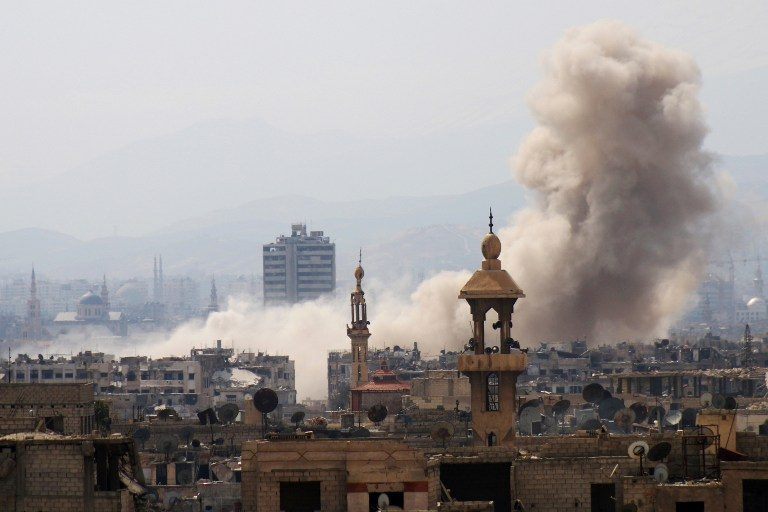SUMMARY
This is AI generated summarization, which may have errors. For context, always refer to the full article.

BEIRUT, Lebanon – Heavy clashes rocked eastern districts of the Syrian capital on Sunday, March 19, as rebels and jihadists tried to fight their way into the city center in a surprise assault on government forces.
The attack comes just days before a fresh round of UN-brokered peace talks in Geneva aiming at ending Syria’s 6-year war.
Rebels and government forces agreed to a nationwide cessation of hostilities in December, but fighting has continued across much of the country, including in the capital.
Steady shelling and sniper fire could be heard across Damascus as rebel factions allied with former Al-Qaeda affiliate Fateh al-Sham Front launched an attack on regime positions in the east of the city.
The attack began early in the day “with two car bombs and several suicide attackers” in the Jobar district, said Rami Abdel Rahman, head of the Syrian Observatory for Human Rights monitoring group.
Rebels seized several buildings in Jobar and advanced into the nearby Abbasid Square area, seizing part of a large bus station before being pushed back by government forces, Abdel Rahman said.
“After a major advance by opposition fighters, the regime got over its shock and began a counter-offensive,” he said.
As dusk fell, rebels shifted their focus to Qabun, a northeastern district of Damascus heavily bombarded in recent weeks by forces loyal to President Bashar al-Assad.
“Rebels want to link their territory in Jobar with Qabun to break the government siege there,” Abdel Rahman added.
Schools close
Regime warplanes have targeted rebel positions with more than 30 air strikes since the morning, he said.
State media reported that the army had successfully “blocked an attack by terrorists on military points and residential buildings in Jobar.”
State television aired footage from Abbasid Square, typically buzzing with activity but now empty because the army had ordered residents to stay indoors.
AFP correspondents in Damascus said army units had sealed off the routes into the square, where a thick column of smoke rose into the cloudy sky.
The few people out on the street moved quickly between buildings, but many stayed in their homes in fear of stray bullets and shelling.
Several tanks were seen entering east Damascus as reinforcements ahead of a possible counter-offensive.
Several schools in the capital announced they would stay closed on Monday, March 20.
Control of Jobar – which has been a battleground for more than two years – is divided between rebels and allied jihadists and government forces.
According to the Observatory, the Islamist Faylaq al-Rahman rebel group and the Fateh al-Sham Front – known as Al-Nusra Front before it broke ties with Al-Qaeda – have a presence in the area. Government forces have long sought to push the rebels out of Jobar because of its proximity to the city center.
But with Sunday’s attack, Abdel Rahman said, “rebels have shifted from a defensive position in Jobar into an offensive one.”
“These are not intermittent clashes – these are ongoing attempts to advance,” he said.
Their incursion into Abbasid Square, though brief, was the first time in approximately two years that rebels had got that close to the center of Damascus.
Israel threatens defense systems
In recent months, the regime has sought to secure territory around the capital with renewed offensives on besieged rebel towns along with local “reconciliation” deals.
Under such agreements, the government agrees to end bombardments and stop besieging towns in exchange for a rebel withdrawal.
On Sunday, dozens of rebels and civilians who had been bused out of the last opposition-held district of Homs city reached northern Aleppo province.
An AFP photographer saw men, women, and toddlers peeking out from behind curtains as the buses headed to Jarabulus, a town on the Syrian-Turkish border.
More than 320,000 people have been killed and millions displaced since Syria’s conflict erupted 6 years ago with protests against Assad’s rule.
After a crackdown, the uprising became an all-out war that has drawn in world powers on nearly all sides.
On Sunday, Israeli Defense Minister Avigdor Lieberman threatened to destroy Syria’s air defense systems after they fired ground-to-air missiles at Israeli warplanes on Friday, March 17.
Syria’s military said it shot down one Israeli jet and hit another as they carried out early morning strikes near the famed desert city of Palmyra.
Israel denied any of its aircraft were hit and said it had been targeting weapons bound for Lebanon’s Hezbollah movement, which backs Assad in Syria.
The United Nations has sponsored peace talks to end the conflict since 2012, but to no avail.
Government representatives and opposition figures are set to meet for a 4th round of negotiations on Thursday, March 23, in Switzerland. – Rappler.com
Add a comment
How does this make you feel?
There are no comments yet. Add your comment to start the conversation.